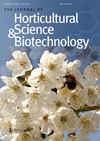火龙果采后贮藏保鲜技术研究进展
IF 2.1
4区 农林科学
Q2 HORTICULTURE
Journal of Horticultural Science & Biotechnology
Pub Date : 2023-10-09
DOI:10.1080/14620316.2023.2263757
引用次数: 1
摘要
摘要火龙果具有很高的食用、药用和经济价值。目前,火龙果经常被用作新鲜水果,以满足消费者的市场需求。但火龙果采收后容易发生机械损伤、微生物感染、软化腐烂等问题,影响新鲜火龙果的品质和保质期。因此,人们开发了许多技术来延长新鲜火龙果的采后贮藏时间。本文综述了影响火龙果采后品质变质的内外部因素,介绍了目前可用的火龙果保鲜技术类型。这包括以自然物质为基础的延长采后火龙果保质期的物理、化学和技术,以及采后病虫害的控制方法。未来的研究需要考虑多种技术的联合应用,以提高火龙果的保存效果。本文由贵州省杰出青年科学家计划资助,项目号KY [2021]028;国家自然科学基金区域基金(32260799);贵州大学种植研究项目(批准号[2019]42)。声明作者声明无利益冲突。数据可用性声明所有相关数据均在文中。更多的信息可以在参考文献中找到。基金资助:国家自然科学基金区域基金[32260799];贵州大学培育研究计划[[2019]42];贵州省杰出青年科学家计划项目[KY[2021]028]。本文章由计算机程序翻译,如有差异,请以英文原文为准。
Recent advances in postharvest storage and preservation technology of pitaya (dragon fruit)
ABSTRACTPitaya fruit has highly edible, medicinal, and economic value. Currently, pitaya is often used as fresh fruit to meet the market demand of consumers. However, pitaya fruit is prone to mechanical damage, microbial infection, and softening and decay after harvest, affecting the quality and shelf life of fresh pitaya fruit. Therefore, many technologies have been developed to extend the postharvest storage time of fresh pitaya. This review summarises the internal and external factors that affect the deterioration in quality of pitaya fruit after harvest and introduces the types of preservation technologies for pitaya fruit presently available. This includes physical, chemical, and techniques based on natural substances to extend the shelf life of postharvest pitaya fruit, as well as the control methods of postharvest diseases and pests. Future research needs to consider the combined application of various technologies to improve the preservation of pitaya.KEYWORDS: PitayapostharvestTechnologypreservationqualityshelf life AcknowledgementsThis review is supported by Outstanding Young Scientist Program of Guizhou Province under grant number KY [2021]028; Regional Fund of the National Natural Science Foundation of China (32260799); Cultivation Research Program of Guizhou University under grant numbers [2019]42.Disclosure statementThe authors declare no conflict of interest.Data availability statementAll relevant data are within the paper. And more information can be found in the references.Additional informationFundingThis work was supported by the Regional Fund of the National Natural Science Foundation of China [32260799]; Cultivation Research Program of Guizhou University [[2019]42]; Outstanding Young Scientist Program of Guizhou Province [KY [2021]028].
求助全文
通过发布文献求助,成功后即可免费获取论文全文。
去求助
来源期刊
CiteScore
3.90
自引率
5.30%
发文量
67
审稿时长
3 months
期刊介绍:
The Journal of Horticultural Science and Biotechnology is an international, peer-reviewed journal, which publishes original research contributions into the production, improvement and utilisation of horticultural crops. It aims to provide scientific knowledge of interest to those engaged in scientific research and the practice of horticulture. The scope of the journal includes studies on fruit and other perennial crops, vegetables and ornamentals grown in temperate or tropical regions and their use in commercial, amenity or urban horticulture. Papers, including reviews, that give new insights into plant and crop growth, yield, quality and response to the environment, are welcome, including those arising from technological innovation and developments in crop genome sequencing and other biotechnological advances.

 求助内容:
求助内容: 应助结果提醒方式:
应助结果提醒方式:


